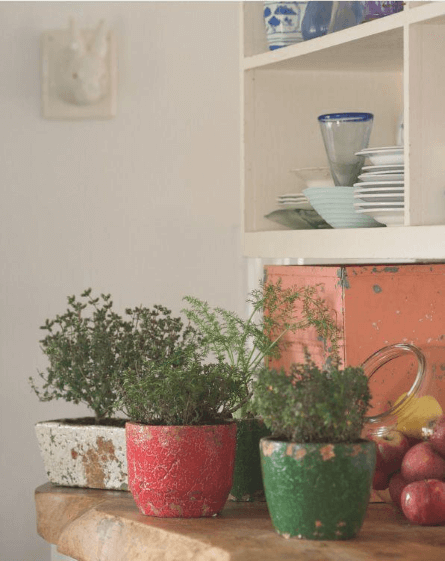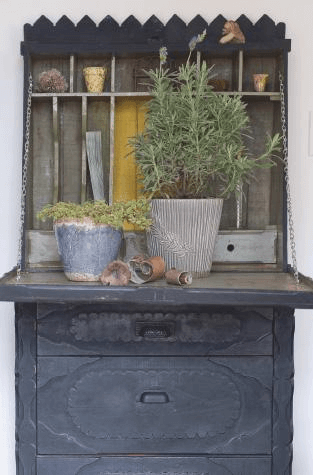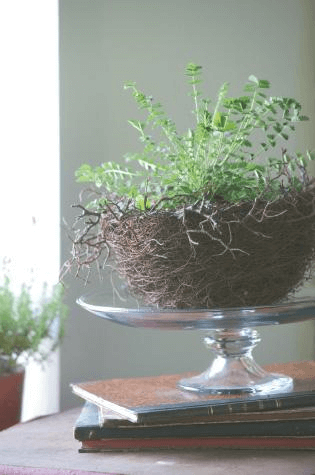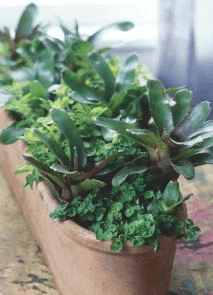[Ebook Việt hóa] The Unexpected Houseplant: 220 Extraordinary Choices for Every Spot in Your Home
[Ebook Việt Hoá] The Unexpected Houseplant: Herbs (cây thuốc)
- Nguồn: [Ebook] The Unexpected Houseplant: 220 Extraordinary Choices for Every Spot in Your Home –
- Biên tập: Dũng Cá Xinh (Tháng 02/2022)
- Dịch: Vui Nguyễn
English
HERBS
ANYBODY CAN GROW an herb during the summer. I habitually season my outdoor garden with parsley, sage, rosemary, thyme, and a long list of other savory plants. Because I’m perennially in a rush (especially around mealtime), I also host herbs in containers just footsteps from the back door, which is, in turn, just a brief commute to the kitchen. In those containers, I slap together various combinations of thymes. ‘Silver Posie’ is a favorite for its white-rimmed leaves and durability when I’ve forgotten to water, but plain old Thymus vulgaris tastes better. Meanwhile, marjoram is a mainstay. They do their job (making summer squash edible and even quasi-interesting), and they revive despite serial wilting. In summer, herbs are a cinch.

Not so in winter. First of all, your roster of applicable herbs is diminished considerably. Right now, if you came to visit, you’d pay call to several pots of Thymus vulgaris (I’m a heavy user), a winter savory (Satureja montana), marjoram (Origanum majorana; I found a cultivar called ‘Compacta’ that remains midget making it perfect for pots), Origanum ‘Silver Anniversary’, cardamom (Elettaria cardamomum), salad burnet (Sanguisorba minor), and Lavandula ‘Goodwin Creek Gray’ in various windows. I had a fennel (Foeniculum vulgare), but someone admired it so excessively that I had no choice but to send it home in her car (it was the holidays, after all). Although I don’t have a single ounce of Puritan blood, each of these herbs is a workhorse. Some are plucked within an inch of their lives to rescue lentil soup from terminal blandness. Others are simply grown for their aromatherapy, loosely applied. And I’m not the only one who indulges. When Einstein was the new kitten on the block, he quickly learned that playing with the herbs didn’t elicit loud or demonstrative rebukes.
Notice that rosemary isn’t in my lineup of herbs. I wish I could include it, but rosemary refuses to survive the winter here. And I’m not alone. I have been told that rosemary prefers cool temperatures, regular watering, bright light, and basically all the other conditions that herbs in general hold dear.
ANYBODY CAN GROW an herb during the summer. I habitually season my outdoor garden with parsley, sage, rosemary, thyme, and a long list of other savory plants. Because I’m perennially in a rush (especially around mealtime), I also host herbs in containers just footsteps from the back door, which is, in turn, just a brief commute to the kitchen. In those containers, I slap together various combinations of thymes. ‘Silver Posie’ is a favorite for its white-rimmed leaves and durability when I’ve forgotten to water, but plain old Thymus vulgaris tastes better. Meanwhile, marjoram is a mainstay. They do their job (making summer squash edible and even quasi-interesting), and they revive despite serial wilting. In summer, herbs are a cinch.
Not so in winter. First of all, your roster of applicable herbs is diminished considerably. Right now, if you came to visit, you’d pay call to several pots of Thymus vulgaris (I’m a heavy user), a winter savory (Satureja montana), marjoram (Origanum majorana; I found a cultivar called ‘Compacta’ that remains midget making it perfect for pots), Origanum ‘Silver Anniversary’, cardamom (Elettaria cardamomum), salad burnet (Sanguisorba minor), and Lavandula ‘Goodwin Creek Gray’ in various windows. I had a fennel (Foeniculum vulgare), but someone admired it so excessively that I had no choice but to send it home in her car (it was the holidays, after all). Although I don’t have a single ounce of Puritan blood, each of these herbs is a workhorse. Some are plucked within an inch of their lives to rescue lentil soup from terminal blandness. Others are simply grown for their aromatherapy, loosely applied. And I’m not the only one who indulges. When Einstein was the new kitten on the block, he quickly learned that playing with the herbs didn’t elicit loud or demonstrative rebukes.
Notice that rosemary isn’t in my lineup of herbs. I wish I could include it, but rosemary refuses to survive the winter here. And I’m not alone. I have been told that rosemary prefers cool temperatures, regular watering, bright light, and basically all the other conditions that herbs in general hold dear.
Cool, bright, and even-handed is a fairly accurate assessment of the state of affairs here. However, rosemary invariably comes down with a nasty (lethal) case of the snivels (symptoms being rot and general leaf collapse, followed by stem disintegration) or powdery mildew. Both of these afflictions make the plant look gross enough to squelch any thoughts of consumption. I love rosemary, but I leave it outdoors, sacrifice it to cold weather, and grow it fresh every year.

Lots of herbs don’t translate indoors. Basil is a good example. Its light demands are too high. In basil’s desperate attempt to seek more sun, it stretches, forms few leaves, and goes to flower in a blink. And what’s basil without leaves? Worthless. Ditto for cilantro. I veer away from sweet bay (Laurus nobilis) because where am I going to host a massive shrub that needs full sun? I like the theory of lovage (Levisticum officinale), but it bolts into flower too rapidly. Sage (Salvia officinalis) is lovely, but it tends to rot without mega-bright sunbeams. The same sorry fate befalls sweet herb (Stevia rebaudiana). I have to skip summer savory (Satureja hortensis) indoors even though it is a vast improvement, taste-wise, over winter savory (Satureja montana, which I do grow quite successfully on my windowsill). As the name implies, summer savory grows best as an annual.

Beyond the inventory that I’ve chosen based on space limitations and culinary taste choices, other herbs would do just fine in my home. The mints, for example, would undoubtedly thrive indoors. Even if they go into a snit and lose leaves, they will soon regrow from the underground rhizomes. I am wild about horehound (Marrubium vulgare) for its deep, throaty, menthol-scented leaves, but I leave it outdoors in the garden where it is nearly evergreen (when not buried in snow). Curly parsley makes a splendid houseplant, and I have entertained it for several winters. Eventually, it will act like a biennial and bolt up into blossom, but not before its leaves have improved many meals for several months. Patchouli (Pogostemon heyneanus) makes a great indoor herb. But it would either be the patchouli or me, because we can’t live in the same house, scent-wise.
What growing conditions do most plants like? As much sun as possible, cool temperatures, a brief dry soil lull between waterings, and lean soil. With the exception of rosemary (whose roots plunge down), most herbs are best grown in tight containers. Skip the fertilizer over the winter. (Many growers suggest forgetting the fertilizer all year because herbs tend to be more flavorful when they grow on lean rations. I find that to be true. The compost in my organic potting soil is sufficient to keep them chugging along beautifully.) Furnishing the cool temperatures is easy for me; I just nestle the herbs close to the windowpanes. But if you live in a normal, comfortable, toasty house, your herbs will also probably be fine. However, they might make leggy growth. And the remedy is to snip them often and add them liberally to dinner. Even those of us who cannot cook become instant chefs with marjoram and some thyme at our beck and call.

- ALSO CALLED: marjoram, oregano, thyme, winter savory, and others
| FLOWERS | Usually to be dissuaded |
| FOLIAGE | The look varies, but the foliage is usually aromatic |
| OTHER ATTRIBUTES |
Often good-looking and readily available |
| SIZE | 6–12 inches (15–30cm) in height |
| EXPOSURE | South or bright west |
| WATER REQUIREMENTS |
Thyme can tolerate drought; other herbs tend to wilt easily |
| OPTIMUM NIGHTTIME TEMPERATURE |
50–65°F (10–15°C) |
| RATE OF GROWTH | Medium |
| SOIL TYPE | Good, heavy potting soil with compost added |
| FERTILIZING | Herb growers suggest not fertilizing because lean herbs are more flavorful |
| PROBLEMS | Aphids |
Tiếng Việt
THẢO MỘC
Ai cũng có thể trồng thảo mộc trong suốt mùa hè. Theo thói quen, tôi trồng rau mùi tây, xô thơm, hương thảo, cỏ xạ hương và một loạt các loại cây rau thơm khác trong khu vườn ngoài trời của mình. Vì tôi thường rất vội vàng (đặc biệt là vào giờ ăn), nên tôi trồng các loại thảo mộc trong các chậu cây chỉ cách cửa sau vài bước chân. Trong những cái chậu đó, tôi kết hợp nhiều loại cỏ xạ hương với nhau. ‘Silver Posie’ được yêu thích nhất vì những chiếc lá có viền trắng và sức chịu đựng tốt khi tôi quên tưới nước, nhưng cây cỏ xạ hương già cỗi vẫn ngon hơn. Trong khi đó, kinh giới là loại cây chủ lực. Chúng làm công việc của mình và có thể hồi sinh mặc dù đã héo. Vào mùa hè, thật tốt khi có các loại thảo mộc.

Trước hết, vào mùa đông, danh sách các loại thảo mộc có thể dùng được bị giảm đi đáng kể. Ngay bây giờ, nếu bạn đến thăm, bạn sẽ được phục vụ vài chậu cỏ xạ hương (tôi là người dùng nhiều), một chậu húng núi (Satureja montana), kinh giới (Origanum majorana; tôi đã tìm thấy một giống cây trồng có tên là ‘Compacta’ vẫn còn sót lại và làm cho nó trở nên hoàn hảo khi trồng trong chậu), Origanum ‘Silver Anniversary’, bạch đậu khấu (Elettaria cardamomum), địa du (Sanguisorba minor) và oải hương ‘Goodwin Creek Grey’ trên các bệ cửa sổ. Tôi cũng có một cây thì là (Foeniculum vulgare), nhưng ai đó yêu thích nó quá mức khiến tôi không còn cách nào khác ngoài việc đặt nó vào xe của cô ấy. Mặc dù tôi không có một chút dòng máu Thanh giáo nào, nhưng mỗi loại thảo mộc này đều là một người làm việc chăm chỉ. Một số đã cây xả thân giải cứu món súp đậu lăng khỏi sự nhạt nhẽo. Những loại khác chỉ đơn giản là được trồng để làm hương liệu. Và tôi không phải là người duy nhất thích thú. Khi Einstein còn là một chú mèo con mới đến, nó nhanh chóng nhận ra rằng chơi đùa với các loại thảo mộc sẽ không gây ồn ào và bị trách mắng.
Lưu ý rằng hương thảo không có trong danh mục các loại thảo mộc của tôi. Tôi ước tôi có thể trồng nó, nhưng hương thảo không sống sót được với mùa đông ở đây. Và tôi không đơn độc. Tôi được biết rằng hương thảo thích nhiệt độ mát mẻ, tưới nước thường xuyên, ánh sáng rực rỡ, và về cơ bản tất cả các điều kiện mà các loại thảo mộc nói chung yêu thích.
Mát, sáng và vô tư là những đánh giá khá chính xác về tình hình công việc ở đây. Tuy nhiên, cây hương thảo luôn đi kèm với các dấu hiệu của chảy mủ (các triệu chứng nói chung là thối và rụng lá, sau đó là thối thân) hoặc bệnh phấn trắng. Cả hai điều phiền não này khiến cây trông thô kệch đến mức khiến bạn không muốn ăn chúng nữa. Tôi yêu hương thảo, nhưng tôi để nó ở ngoài trời, hy sinh nó trong thời tiết giá lạnh, và trồng mới hàng năm.

Rất nhiều loại thảo mộc không thể trồng trong nhà. Húng quế là một ví dụ điển hình. Nhu cầu ánh sáng của nó quá cao. Với những nỗ lực đầy tuyệt vọng của húng quế khi tìm kiếm thêm ánh nắng mặt trời, nó vươn dài ra, hình thành một vài chiếc lá và ra hoa trong nháy mắt. Khi húng quế không còn lá thì? Vô giá trị. Chuyển đến rau mùi. Tôi không trồng nguyệt quế (Laurus nobilis) bởi vì tôi biết trồng một cái cây bụi khổng lồ cần nhiều ánh nắng mặt trời ở đâu? Tôi thích cần núi (Levisticum officinale), nhưng nó nở hoa quá nhanh. Cây xô thơm (Salvia officinalis) rất đáng yêu, nhưng nó thường bị thối nếu không có ánh nắng chói chang. Tương tự, số phận đáng tiếc ập đến với cỏ ngọt (Stevia rebaudiana). Tôi phải bỏ qua húng mùa hè (Satureja hortensis) mặc dù nó là một cải tiến lớn, hợp khẩu vị hơn húng mùa đông (Satureja montana, loại cây tôi trồng khá thành công trên bệ cửa sổ của mình). Như tên của nó, húng mùa hè phát triển tốt cả năm.

Ngoài những cây mà tôi đã chọn dựa trên giới hạn về không gian và lựa chọn dựa trên hương vị, các loại thảo mộc khác sẽ phát triển tốt trong nhà. Ví dụ, bạc hà chắc chắn sẽ phát triển mạnh trong nhà. Ngay cả khi chúng chuyển sang giai đoạn sinh sản và rụng lá, chúng sẽ sớm mọc lại. Tôi rất hoang mang với húng đắng lông trắng (Marrubium vulgare) vì những chiếc lá nhiều lông, sần sùi, có mùi thơm của tinh dầu bạc hà, nhưng tôi lại để nó ở ngoài trời, nơi nó gần như vẫn xanh (khi không bị vùi trong tuyết). Ngò tây xoăn là một loại cây trồng trong nhà tuyệt đẹp, và tôi đã dùng nó trong vài mùa đông. Cuối cùng, nó vẫn giống như cây hai năm, nó phải đơm hoa kết trái, nhưng không phải trước khi lá của nó đã cải thiện nhiều bữa ăn trong vài tháng của tôi. Cây hoắc hương (Pogostemon heyneanus) là một loại thảo mộc trong nhà tuyệt vời. Nhưng chỉ có thể chọn hoắc hương hoặc tôi, bởi vì chúng tôi không thể sống chung một nhà do mùi hương của nó.
Điều kiện phát triển của hầu hết các loại thực vật là gì? Càng nhiều nắng càng tốt, nhiệt độ mát mẻ, đất khô trong thời gian ngắn và đất tơi xốp. Ngoại trừ cây hương thảo (có rễ đâm xuống), hầu hết nên trồng các loại thảo mộc trong thùng kín. Bỏ qua phân bón vào mùa đông. (Nhiều người trồng đề nghị không bón phân quanh năm vì các loại thảo mộc sẽ thơm hơn khi không quá tốt. Tôi thấy điều đó đúng. Phân trộn trong bầu đất hữu cơ đã đủ để giữ cho chúng tươi tốt.) nhiệt độ thì dễ dàng rồi; Tôi chỉ cần đặt các loại thảo mộc gần ô cửa sổ. Nhưng nếu bạn sống trong một ngôi nhà bình thường và thoải mái, các loại thảo mộc có lẽ cũng sẽ ổn. Tuy nhiên, chúng có thể vươn dài lên. Và cách khắc phục là cắt tỉa thường xuyên và thêm chúng vào bữa tối. Ngay cả những những người không thể nấu ăn cũng trở thành những đầu bếp ngay lập tức với một ít rau kinh giới và một ít cỏ xạ hương.

- HAY CÒN GỌI LÀ: kinh giới, oregano, cỏ xạ hương, húng mùa đông, và các loại khác
| HOA | có hoa |
| LÁ | lá trông khác nhau nhưng thường có mùi thơm |
| THUỘC TÍNH KHÁC | trông đẹp, có sẵn |
| KÍCH THƯỚC | cao 6–12 inches (15–30cm) |
| ÁNH SÁNG | phía nam và phía tây sáng sủa |
| YÊU CẦU VỀ NƯỚC | cỏ xạ hương chịu được khô hạn; các loại thảo mộc khác có xu hướng dễ héo |
| NHIỆT ĐỘ TỐI ƯU BAN ĐÊM | 50–65°F (10–15°C) |
| TỐC ĐỘ PHÁT TRIỂN | trung bình |
| LOẠI ĐẤT | đất trồng chậu tốt, chắc, có thêm phân trộn |
| BÓN PHÂN | Những người trồng thảo mộc đề xuất không bón phân vì các loại thảo mộc không quá mập sẽ thơm hơn |
| VẤN ĐỀ | rệp |



